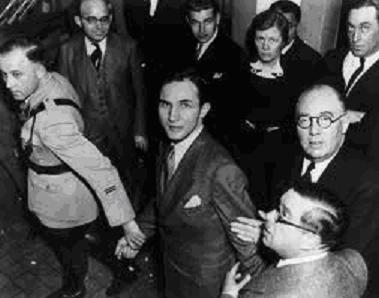*Image Credit: Wikimedia Commons In an era when sensationalism ruled the papers, the story of Charles Lindbergh, Jr. captured the imagination during the period between Great Wars. The 20-month-old boy, born to world-renowned pilot Charles Lindbergh and his wife Anne in 1930, was kidnapped on March 1, 1932 and found dead two months later. After a two-year investigation, police finally managed to track down the culprit, Bruno Hauptmann, on September 19, 1934. The night of March 1, 1932 began much like any other evening in the Lindbergh household in East Amwel, New Jersey: at 8pm, the young child was put to bed by the nurse-maid while his parents began to unwind. About 90 minutes later, a noise broke the evening’s silence. Charles Sr., believing it to have come from the kitchen, thought little of it and went back to focusing on his work in the study. The nurse-maid returned to the baby’s room at 10pm, discovering an empty crib. She asked Anne if the boy was with her, then went downstairs to speak with Charles Sr. Alarmed, he climbed the stairs and entered the room, noticing a small white envelope placed on the window sill. Within a half hour, local police and media had burst on the scene. Within minutes, a makeshift ladder was found in the bushes, but investigators could not pull together much in the way of evidence due to the throng of reporters gathered outside. With only a ransom note demanding $50,000 dollars, the case soon became a worldwide phenomenon. Believing someone in German organized crime had abducted the boy, Charles Sr. and others began directing detectives toward mob bosses in New York City. A handful of imprisoned criminals — famously Al Capone — offered themselves up as aids to the investigation in exchange for release from prison. (All were denied.) Before long, President Herbert Hoover authorized the Bureau of Investigation (precursor to the FBI), Coast Guard and other federal agencies to participate in the manhunt while the Lindberghs pooled together their resources with those of the state of New Jersey to offer a $75,000 reward for the child’s safe return. Fueled by media speculation and tipsters, the story grew. Within days, two more ransom letters had arrived amidst a sea of copycats, with the second demanding an increased ransom of $70,000 now that the police had been involved. Two weeks later, John Condon, an agent working on Lindbergh’s behalf, received the baby’s nightclothes in the mail. By the end of the month, Condon had received word from the kidnappers they were ready to accept payment. After a long taxi ride through Manhattan, Condon and Lindbergh delivered the special-made box filled with gold certificates — currency being pulled from circulation — and unmarked bills to the suspect at St. Raymond’s Cemetery. Having brushed aside the police at the father’s request, Condon handed over the carefully-selected $50,000 (in the hopes the package might help the kidnappers be identified) and received word the child was in a boat named Nelly docked up the coast at Martha’s Vineyard. Lindbergh flew up to find his son, unable to locate the boat. After several days of flying past the seaside town at low altitude, he realized he had been duped. When his son’s decomposing body was found just 4.5 miles from his home on May 12, 1932, the sad reality became a nightmare. The case was cold and the press attention was out of control. For two-and-a-half years, police and federal investigators attempted to track the money. Finally, in July 1934, a single gold certificate with a license plate number scribbled along the edge gave them the break they needed. Tracing the information to a gas station in the Bronx, authorities arrested Bruno Hauptman on September 19, 1934 after finding more than $14,000 worth of ransom money in his home — at the height of the Great Depression, no less. Though he insisted he had no knowledge of the crime, saying the money belonged to a friend who had passed away months before, Hauptmann’s home told a far different story. Police found a notebook with a sketch matching the ladder found in the bushes and, when added to specific information about John Condon, Hauptmann was indicted for extortion and murder on September 24th. Found guilty in mid-February 1935 after a six-week trial, he died in the electric chair on April 3, 1936.
September 19, 1934 CE – Bruno Hauptmann is Arrested for the Murder of Charles Lindbergh, Jr.
*Image Credit: Wikimedia Commons In an era when sensationalism ruled the papers, the story of Charles Lindbergh, Jr. captured the imagination during the period between Great Wars. The 20-month-old boy,…
560
